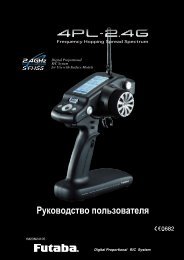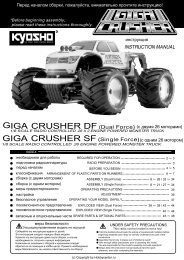Mirage handleiding
Mirage handleiding
Mirage handleiding
Sie wollen auch ein ePaper? Erhöhen Sie die Reichweite Ihrer Titel.
YUMPU macht aus Druck-PDFs automatisch weboptimierte ePaper, die Google liebt.
Assembly: (pictures page 8)<br />
1. Cut the vacuum-formed canopy out of the plastic. Sand or cut the edges so it fits perfect over the fuselage. You can make a small hole on<br />
front of the canopy as a battery cooling intake.<br />
2. Remove the foam behind the battery compartiment, it will give the battery more room backwards when adjusting the CG balance.<br />
3. Use epoxy to glue the 2 small pieces of plywood in the slots on the fuselage next to the canopy.<br />
4. Cut out the vacuum-formed nose cap and glue it to the front of the fuselage. Tip: first paint the inside of the cap to avoid scratches.<br />
5. Glue the vertical fin to the fuselage. Be sure to align correctly.<br />
6. Mount the motor to the mount plate and glue it to the tail of the fuselage. Align the centerline with the fuselage parting line to obtain an<br />
angle of 2° upwards.<br />
7. Cut out the vacuum-formed jet nozzle, remove the marked area to obtain motor cooling. You can also paint the nozzle from the inside.<br />
Mark the position of the screws and drill the holes. Now the motor can be tightened with the supplied screws.<br />
8. Glue the remaining 4 plywood pieces in the slots on the underside of the fuselage. Glue the servos in the slots, you can use the supplied<br />
double-sided tape, epoxy or hot glue. (Degrease first).<br />
9. Cut out the vacuum-formed plastic fuselage bottom cover and cut out the position of the servos. You can also cut out the hand grip<br />
position. Mark the holes for the 4 screws and drill the holes in the plastic and the plywood. You can now paint the inside of the fuselage<br />
bottom cover.<br />
10. Glue the main wings to the fuselage with epoxy. Be carefull to align the leading and trailing edges with the fuselage parting line.<br />
11/12.Cut slightly to pass through the elevon horn grooves. Snap the elevon control horn sets together.<br />
13. Cut off and remove +/- 1 mm from the outer and inner side of the ailerons.<br />
14. Place the receiver and speed controller into the fuselage and connect them properly. Make sure the battery connectors are accessible<br />
through the bottom hole of the fuselage. Connect the ailerons through the pushrods and plastic clevises.<br />
The centre of gravity (CG) is located at 135-150 mm from the leading edge of the wing. Move the battery more forward or aft until the CG is<br />
correct.<br />
The standard elevon trim is +/- 2 mm up. If necessary, you can glue the two vacuumformed turbulators to the wing tips.<br />
Be sure to set the controls up in the following manner:<br />
Elevator UP: both elevons up (5-8 mm).<br />
Aileron RIGHT (as seen from behind): RIGHT elevon UP (5-8 mm), LEFT elevon down (5-8 mm).<br />
First flight<br />
First check the range of your radio.<br />
Ask someone with experience to firmly launch the model straight into the wind. If the model cannot climb properly, the elevon trim is too high,<br />
move the CG backwards.<br />
If the model is assembled perfectly and properly setup, it will fly level after a high speed dive. If the model tends to go up, move the CG<br />
backwards. If the model continues to dive, move the CG forwards.<br />
We wish you any happy flights with your <strong>Mirage</strong> 2000.<br />
<strong>Mirage</strong> - 5






![GER_P033(FW-06 Chassis) EX [Konvertiert].ai](https://img.yumpu.com/28766382/1/177x260/ger-p033fw-06-chassis-ex-konvertiertai.jpg?quality=85)
